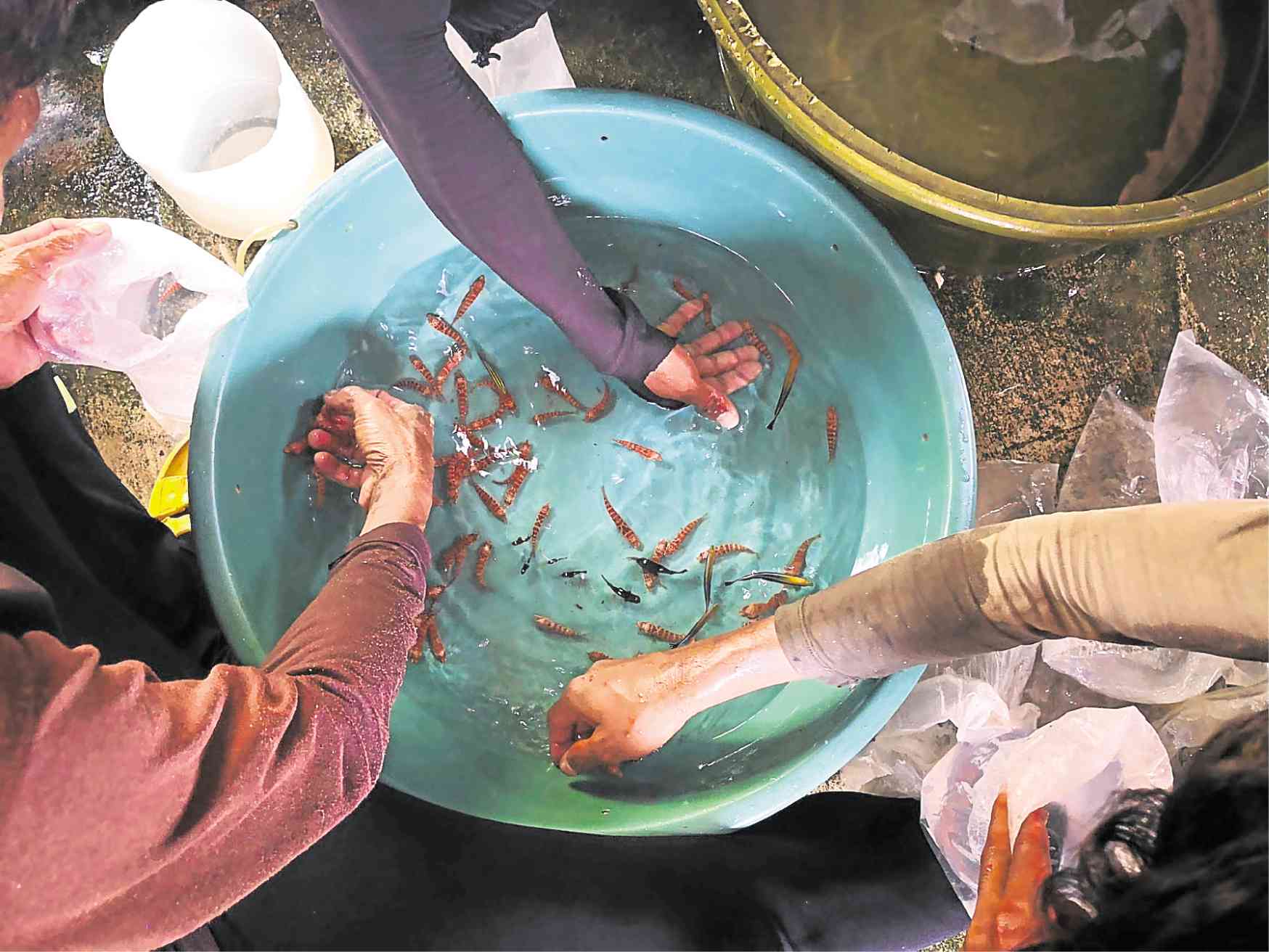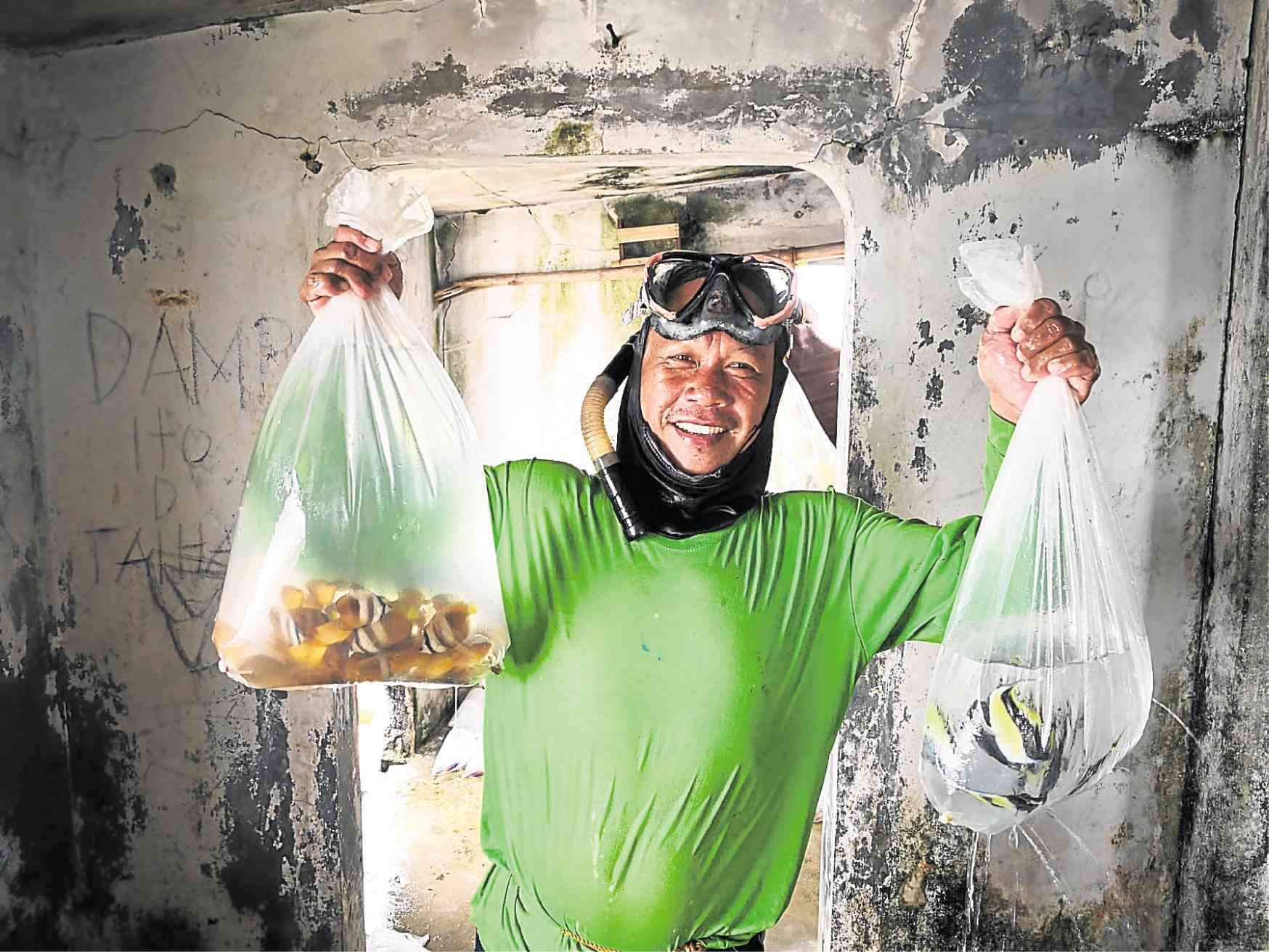High risk, low pay for reef fish catchers

PRIZED CATCH For decades, aquarium fishing has been a major source of income for families in San Andres, a tightly knit community on Verde Island in Batangas province. —PHOTOS BY CLIFFORD NUÑEZ
(First of two parts)
VERDE ISLAND, BATANGAS—Work peaks every Wednesday for 52-year-old Sandro Pagkaliwagan. As early as 3 a.m., he starts his chores, changing seawater in clear plastic bags thick enough not to tear and pumping oxygen for the live fish inside. He loads the bags onto a boat for transport from Verde Island to Batangas City by noon.
“It’s as if (there’s an occasion) that keeps everyone around busy,” he said.
For aquarium fish traders like Pagkaliwagan, it’s a long—and painstaking—day to ship their harvest safely from Batangas province to Manila, hoping that their week’s catch from diving at risk to reefs at the sea bottom could be sold at pet shops and would bring money to buy food and other things for their families.
The industry, dominated by men, remains the primary, if not the only, source of livelihood in Barangay San Andres, a backward community of 300 families on Verde Island in Batangas. There is hardly any flat land to till or sandy beaches to lure investors.
Article continues after this advertisementVerde Island lies in the middle of the Verde Island Passage (VIP), a 1.14 million-hectare strait in the Mindoro-Calavite-Tablas triangle which was declared the “center of the center of marine shore fish biodiversity” by scientists Kent Carpenter and Victor Springer in 2005. Their finding was supported by a 2006 study of the University of the Philippines Visayas Foundation Inc. and the Marine Science Institute showing “high densities of fish eggs and larvae” around it.
Article continues after this advertisementGlobal demand
Though they are aware of the bounty in the surrounding seas, the people of San Andres are at the extreme end of the multimillion-dollar tropical fish industry. They get just a thin slice of the revenue pie from their harvest of clownfish, damselfish, anthias, tomato anemonefish, wrasse, butterflyfish, lionfish, moorish idol, parrotfish and other species.
For one, the clownfish has become the market favorite, its global demand spurred by the 2003 movie “Finding Nemo,” but which the fish collectors sell for only P15 apiece.
Angelfish costs P100 to P120 each; lionfish, P40; wrasses, P20; and fishes of the genus Chromis, the cheapest at P5.
In the United States, online price lists of pet shops show that common species, like angelfish, are each sold for $30 to $50, or P1,620 to P2,700.
“We don’t have a say on the price and we don’t really ask the ‘amo’ (boss.) All we know is that (the fish) must be shipped out by Thursday, Friday, or Saturday,” said Pagkaliwagan, who has mastered the routine from decades of collecting and selling wild reef fish for ornament.
They are, however, not allowed to deliver more than what the wholesaler had ordered for the week as the warehouse could only stock as much. On Verde Island, the fish are usually kept in roughly made concrete storerooms until the following Wednesday.
Manila pet shops
Fish collectors and traders earn from P5,000 to P10,000 a month. Traders allow a 10- to 15-percent price markup for wholesalers, who export the fish to retailers in the United States, European countries and Japan.
Manila is speckled with hundreds of wholesalers and pet shops, most of them located near the international airport. But a Bureau of Fisheries and Aquatic Resources (BFAR) list showed only 21 registered tropical fish exporters, mostly are in Muntinlupa, Las Piñas and Parañaque cities.
Excesses in stock or fish of poor quality end up in the popular pet complex in Pasay City, fish collectors say.
Globally, marine aquarium is a multimillion-dollar trade, with the Philippines among the top export countries. (The UN Environment Programme, or UNEP, in 2003 estimated it at $200 million to $330 million, while the World Wide Fund for Nature-Philippines in 2013 said it could be over $1 billion.)
In 2008, the Philippines exported about $7 million worth of live ornamental fish, 98 percent of which were caught in the wild, according to a 2010 report by the Globefish Research Programme.
“Trade in marine fish or any marine product is often called a cutflower industry. When it dies or (in the case of a flower) withers, you just buy a new one. And usually, nothing (fish) survives that long in captivity—probably just weeks or months unlike when they are in the wild,” said Emerson Sy of the Philippine Center for Terrestrial and Aquatic Research.
Sy also described aquarium fishing as a “demand-driven” industry, though there has been no study yet showing of particular species traded that are in danger of extinction.

FRAGILE EXPORT Fish collectors store their live catch in plastic bags until they are ready for transport to Metro Manila. Ornamental fish gathered from the waters of Verde Island Passage are exported to as far as the United States.
Conservation efforts
While several organizations acknowledge the economic contribution of the industry, especially in developing countries, conservationists frown upon its unsustainable and destructive ways.
The city government of Batangas plans to ban aquarium fishing by 2020 and replace it with a more sustainable livelihood, said city fisheries chief Gerry Peralta.
While there is as yet no study to show the direct impact of aquarium fishing to ecological imbalance, Peralta noted a downtrend of fish stock in Batangas. BFAR records showed a “remarkable decline” from 21,000 metric tons to 4,000 MT from 1987 to 1995 due to coral bleaching, pollution and unsustainable and excessive fishing.
Compressor-diving also poses a lot of risks to fish collectors on Verde Island.
In skin-tight clothes and improvised wooden fins, they dive 15 to 45 meters deep in search of their targets. The rarer the fish, the higher its price in the market, they say.
A compressor on a boat pumps the oxygen through a hose that serves as the divers’ underwater lifeline.
Cyanide use
“It’s not like how a scuba tank works,” said San Andres village leader, Arnold Briton, who was once a fish collector himself. “The oxygen (from the compressor) is not even filtered, you’d sometimes (get a) taste of the oil.”
In many cases when the compressor fails, fishermen race up to the surface, resulting in “bends” or nitrogen buildup in their bodies. Many suffer from decompression sickness, develop hearing or lung problems, or end up paralyzed or dead, Briton said.
Aquarium fishing is globally known for the use of sodium cyanide. The toxic chemical squirted on the reefs stuns the fish making it easier for the fisherman to snag it.
The International Marinelife Alliance (IMA) traced early use of cyanide in the Philippines in 1962, adding that for every cyanide-caught fish, about a square yard of coral was destroyed.
In 1989, the IMA and the Haribon Foundation trained Verde Island fishermen to shift from cyanide-fishing to using handheld dip nets.
Fish collector Tranquelino Mariano, 63, swore they had abandoned the use of the chemical since, realizing that the captured fish were disfigured (a fin lost or its scales damaged) or died easily.
Often, Briton said aquarium collectors run into trouble with the Bantay Dagat (sea patrols) personnel, who believe they still practice cyanide fishing.
Fishing bans and marine sanctuaries on the VIP have reduced their fishing grounds, forcing them to go farther out and deeper into the seas to meet the industry demand.
“We understand (the predicament) because it’s their livelihood at stake. That’s why what has been agreed to is a gradual phaseout,” Peralta said.
Dialogues with the community have been going on for the last 18 years with proposals for in-captive fish breeding or tourism projects on Verde Island.
But without a concrete alternative, Briton said aquarium fish collectors can’t help but worry about the future.